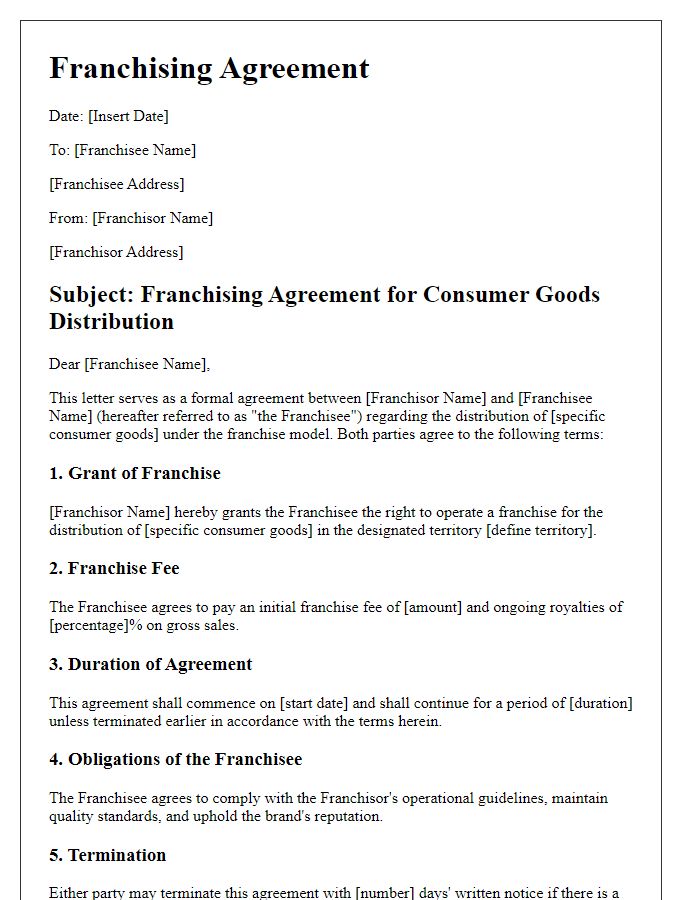Are you looking to streamline your consumer goods distribution process? Creating a solid distribution contract is essential to ensure all parties have a clear understanding of their responsibilities and expectations. From pricing terms to delivery schedules, every detail can make a significant impact on your business operations. Join us as we delve deeper into the key components of an effective distribution contract that can set you up for success!

Parties Involved and Contact Information
The distribution contract outlines the relationship between the distributor and the manufacturer of consumer goods, such as household products, electronics, or personal care items. For clarity, the primary parties involved are the Manufacturer (Company Name, located at Manufacturer Address, Contact: Manufacturer Contact Information) and the Distributor (Company Name, located at Distributor Address, Contact: Distributor Contact Information). Essential data, including business registration numbers and relevant industry certifications, strengthen the legitimacy of both parties. Contact information must include direct phone numbers, email addresses, and designated representatives for effective communication. A thorough identification of parties enhances accountability and sets the foundation for successful collaboration within the consumer goods market.
Definition of Goods and Scope of Distribution
A comprehensive consumer goods distribution contract outlines the specific definition of goods involved in the agreement, alongside the scope of distribution. The "Goods" section identifies the products, such as organic snacks, electronic gadgets, or household cleaning supplies, specifying relevant details like brand names, packaging sizes (e.g., 250g for snacks or 500ml for cleaning supplies), and any unique characteristics (e.g., eco-friendly packaging or gluten-free certifications) that distinguish these items in the marketplace. The "Scope of Distribution" delineates the geographical area for distribution, which could encompass local, regional, or national markets, alongside specific sales channels including e-commerce platforms, retail stores, or wholesale outlets. Additionally, this section may define target sales volumes (e.g., 10,000 units per quarter) and marketing responsibilities, ensuring both parties understand their roles in promoting and selling the goods effectively.
Terms of Payment and Pricing Structure
The Terms of Payment and Pricing Structure within a consumer goods distribution contract establish critical financial frameworks between involved parties. Typically, payment terms specify a net 30-day period (or other agreed duration) for invoice settlements, outlining acceptable payment methods such as bank transfers or checks. Pricing structures may incorporate wholesale pricing, discount tiers based on order volume, and promotions for seasonal products, facilitating a competitive business landscape. Additionally, clauses addressing late payment penalties (often 1.5% per month) and adjustments for raw material cost fluctuations ensure transparency and fairness for both distributors and retailers. Documentation of any rebate agreements, promotional allowances, or exclusive pricing arrangements further enhances clarity in the fiscal relationship.
Distribution Territory and Market Segments
A well-defined distribution territory, such as the Midwestern United States, plays a crucial role in consumer goods distribution. This region includes key states like Illinois, Ohio, and Michigan, offering access to major urban centers such as Chicago and Detroit. Within this territory, market segments such as grocery chains (e.g., Walmart), pharmacy retailers (like CVS), and specialty health stores (such as Whole Foods) represent significant opportunities for product penetration. Additionally, understanding demographic factors such as population density (approximately 12 million in Illinois alone) and consumer behavior trends (increased focus on organic products) further aids in optimizing distribution strategies. An effective contract must delineate these parameters clearly to ensure successful market reach and compliance with regional regulations.
Performance Metrics and Reporting Requirements
The Performance Metrics and Reporting Requirements section of a consumer goods distribution contract outlines essential standards and expectations regarding inventory levels, sales performance, and customer satisfaction. Key performance indicators (KPIs) such as order fulfillment rates (ideally above 95%), average delivery times (target under 72 hours), and inventory turnover ratios (recommended 4-6 times per year) must be defined. Regular reporting intervals, typically on a monthly basis, are crucial for ensuring that both parties remain informed about sales trends and stock levels. Data collection methods may include electronic point-of-sale systems and warehouse management tools, enabling precise tracking of product movement and availability. Periodic reviews should occur quarterly to assess performance against benchmarks and facilitate discussions for potential improvements, ensuring alignment with overarching business goals and consumer demand fluctuations.
Letter Template For Consumer Goods Distribution Contract Samples
Letter template of commercial distribution arrangement for consumer goods

Letter template of partnership contract for distributing consumer products

Letter template of franchising agreement for consumer goods distribution











Comments